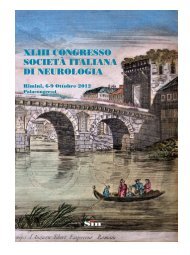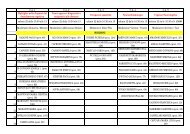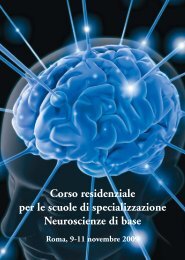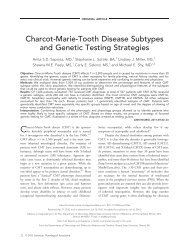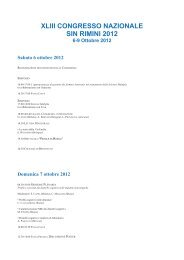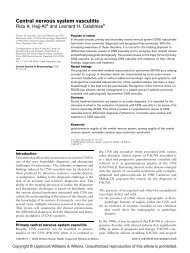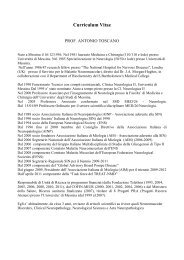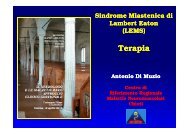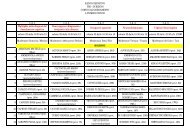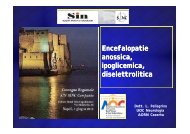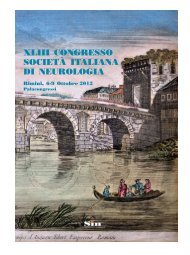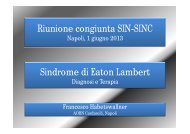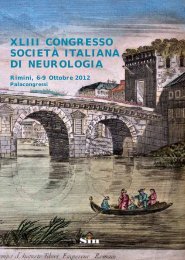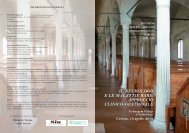658 | Brain 2010: 133; 655–670 W. G. Leen et al.Single or multiple exon deletions or duplications of <strong>the</strong> SLC2A1 geneusing multiplex ligation-dependent probe amplification were analysedin all patients. Multiplex ligation-dependent probe amplification is atechnique for measuring allele dosage and identifies <strong>the</strong> targetsequence by hybridization of two adjacent complementary probes(Schouten et al., 2002). Multiplex ligation-dependent probe amplificationwas carried out using <strong>the</strong> SALSA MLPA kit P138 SLC2A1 (MRCHolland, Amsterdam, The Ne<strong>the</strong>rlands) according to <strong>the</strong> manufacturer’sinstructions. A visual comparison of <strong>the</strong> peak profiles wasmade to identify copy number changes. Heterozygous deletions ofprobe recognition sequences should give 35–50% reduced relativepeak area of <strong>the</strong> amplification product of that probe.Statistical analysisStatistical analyses were performed using Statistical Package for <strong>the</strong>Social Sciences version 16.0 (SPSS INC, Chicago, IL, USA). Mean differencesin CSF parameters between patients with a different genotypeor phenotype were assessed by means of analysis of variance(one-way ANOVA) using planned contrasts for group comparisons.Correlation between phenotype and genotype was tested using <strong>the</strong>Pearson Chi square test (two-sided testing for a significance level ofP 4 0.05).ResultsMolecular dataOut of 57 patients, 6 (11%) were identified with a multiple exondeletion of <strong>the</strong> SLC2A1 gene detected by multiplexligation-dependent probe amplification. In 51 patients a pathogenicmutation in <strong>the</strong> SLC2A1 gene was identified by DNAsequence analysis (Table 1). We identified 37 different novelpathogenic mutations, including 13 missense, 5 nonsense,13 frame shift, 4 splice and 2 translation initiation mutations. Weidentified two different de novo mutations in amino-acid residue1 (c.1A4G and c.3G4A). Since <strong>the</strong> mutations were located in <strong>the</strong>transcription codon of <strong>the</strong> SLC2A1 gene, transcription was notinitiated, which is consistent with haplo-insufficiency. We identified17 different missense mutations in <strong>the</strong> SLC2A1 gene, 13 ofwhich were novel. Eleven novel missense mutations wereidentified in patients with <strong>the</strong> classical phenotype of GLUT1 <strong>deficiency</strong><strong>syndrome</strong> of epilepsy and mental retardation in combinationwith movement disorders (p.Asn34Tyr, p.Met96Val, p.Ala155Val,p.Arg212Cis, p.Arg212His, p.Arg223Trp, p.Glu329Gln,p.Arg333Gln, p.Gly382Asp, p.Ala405Asp, p.Pro485Leu). Thenovel missense mutation p.Arg153His was identified in Patient 48with <strong>the</strong> non-classical phenotype of mild mental retardation withcontinuous ataxia and paroxysmal dystonia and choreoa<strong>the</strong>tosis.CSF in this patient showed a characteristic pattern of low CSF glucose(1.8 mmol/l) in combination with low CSF : blood glucose ratio(0.38) and low CSF lactate (1.0 mmol/l). The novel missense mutationp.Val303Leu was identified in Patient 57. This patient was lostas follow-up and <strong>clinical</strong> data were unavailable. DNA of <strong>the</strong> parentsof this patient was not investigated.All previously unreported mutations were verified in a panel ofat least 100 control alleles. Mutations were not mentionedas non-pathogenic polymorphism in <strong>the</strong> Single NucleotidePolymorphism database. Two mutation prediction programs wereused to predict <strong>the</strong> pathogenicity of mutations [PolyPhen(Polymorphism Phenotyping) and SIFT (Sorting Intolerant fromTolerant)]. The mutations that we identified and all mutations in<strong>the</strong> SLC2A1 gene that have been described previously are representedin Fig. 1 (Klepper et al., 2007; Klepper and Leiendecker,2007; Ito et al., 2008; Joshi et al., 2008; Roulet-Perez et al., 2008;Suls et al., 2008; Takahashi et al., 2008; Ticus et al., 2008; Weberet al., 2008; Zorzi et al., 2008; Bertsche et al., 2009; Slaughteret al., 2009).Autosomal dominant transmissionWe identified four families with autosomal dominant transmissionof GLUT1 <strong>deficiency</strong> <strong>syndrome</strong>. Patient 11 (Table 2), <strong>the</strong> mo<strong>the</strong>rof Patient 49 (Table 4) was diagnosed with GLUT1 <strong>deficiency</strong><strong>syndrome</strong> after diagnosis was made in her daughter. Whereasher daughter had a non-classical phenotype, with mild mentalretardation with continuous ataxia with paroxysmal worsening,<strong>the</strong> mo<strong>the</strong>r had <strong>the</strong> early-onset classical phenotype of epilepsywith mild mental retardation and paroxysmal ataxia.Patient 55, <strong>the</strong> mo<strong>the</strong>r of Patient 23 (Table 2), was diagnosedwith GLUT1 <strong>deficiency</strong> <strong>syndrome</strong> after diagnosis was made in herson. The son had <strong>the</strong> early-onset classical phenotype with a mildmental retardation without movement disorders, whereas <strong>the</strong>mo<strong>the</strong>r had a minimal phenotype with a normal psychomotordevelopment and ‘clumsiness’ after prolonged fasting.The missense mutation Arg93Trp was also identified in <strong>the</strong>bro<strong>the</strong>r and mo<strong>the</strong>r of Patient 50 (Table 4). Patient 50 had anon-classical phenotype of severe mental retardation withchorea. The bro<strong>the</strong>r had epilepsy and a mild mental retardation.The mo<strong>the</strong>r had epilepsy and a normal intelligence within <strong>the</strong>lower range (based on <strong>the</strong> <strong>clinical</strong> impression of <strong>the</strong> treatingphysician).In one o<strong>the</strong>r family <strong>the</strong> mutation in <strong>the</strong> SLC2A1 gene was mostlikely transmitted in an autosomal dominant way. A mutation in<strong>the</strong> SLC2A1 gene was identified in Patient 45 (Table 3) after diagnosisof GLUT1 <strong>deficiency</strong> <strong>syndrome</strong> was made in his bro<strong>the</strong>r(Patient 15, Table 2). Patient 15 had <strong>the</strong> early-onset classical phenotypewith severe mental retardation, whereas Patient 45 had<strong>the</strong> late-onset classical phenotype with only mild mental retardation.DNA of <strong>the</strong>ir mo<strong>the</strong>r was investigated and did not show <strong>the</strong>mutation. Clinical data and DNA of <strong>the</strong> fa<strong>the</strong>r were unavailable.In all o<strong>the</strong>r cases where both parents had been tested (n = 11;22%) <strong>the</strong> mutation had occurred as a de novo event.Biochemical characteristicsThe biochemical characteristics of <strong>the</strong> patients are listed inTables 2—4. All patients had low CSF glucose concentrations(52.5 mmol/l). The CSF glucose values (reference range 2.5–3.7 mmol/l) were 0.9–2.4 mmol/l (mean 1.8 mmol/l; SD 0.3).CSF : blood glucose ratios (reference range 0.5–0.8) ranged from0.19 to 0.52 (mean 0.37; SD 0.07). CSF lactate (reference range1.3–1.9 mmol/l) ranged from 0.6 to 1.5 mmol/l (mean 1.0 mmol/l;SD 0.2), with a CSF lactate below 1.3 mmol/l in 78% of <strong>the</strong>patients.Downloaded from http://brain.oxfordjournals.org at centro sperimentale di medicina e biotecnologie-cnr on August 5, 2010
Clinical and genetic spectrum of GLUT1DS Brain 2010: 133; 655–670 | 659Table 1 Mutations in <strong>the</strong> SLC2A1 gene in 51 novel GLUT1 <strong>deficiency</strong> <strong>syndrome</strong> patientsExon Nucleotide AminoacidLocationType ofmutationPatientnumberPhenotypeReferences a1 c.1A4G p.Met1? Transcription codon B 42 B –1 c.3G4A p.Met1? Transcription codon B 26 A –Intron 1 c.18 + 1G4C – – B 24 A –Intron 1 c.18 + 1G4A – – B 23, 55 A, minimal Wang et al., 20002 c.32_33del – Helix 1 B 21 A –2 c.100A4T p.Asn34Tyr Extracellular loop 1–2 A 1 A –Intron 2 c.115-1G4A – – B 17 A –3 c.124G4T p.Glu42X Extracellular loop 1–2 B 46 B –3 c.160G4T p.Glu54X Extracellular loop 1–2 B 54 C –3 c.170dup – Extracellular loop 1–2 B 18 A –4 c.277C4T p.Arg93Trp Cytoplasmic loop 2–3 A 50 C Joshi et al., 20084 c.286A4G p.Met96Val Helix 3 A 3 A –4 c.305_308del – Helix 3 B 43 B –4 c.338_352delinsTTGAG – Helix 3 B 13 A –4 c.354_355insT – Extracellular loop 3–4 B 14 A –4 c.376C4T p.Arg126Cys Helix 4 A 6, 11, 47, 49 A, A, C, C Pascual et al., 2002;Zorzi et al., 20084 c.388G4A p.Gly130Ser Helix 4 A 5 A Wang et al., 20054 c.458G4A p.Arg153His Cytoplasmic loop 4–5 A 48 C –4 c.464C4T p.Ala155Val Helix 5 A 39, 37 B, B –4 c.481C4T p.Gln161X Helix 5 B 28 A –4 c.505_507del – Helix 5 B 20 A Pascual et al.2002;Wang et al., 20055 c.634C4T p.Arg212Cys Cytoplasmic loop 6–7 A 8 A –5 c.635G4A p.Arg212His Cytoplasmic loop 6–7 A 7 A –5 c.667C4T p.Arg223Trp Cytoplasmic loop 6–7 A 40 B –6 c.715_716insC – Cytoplasmic loop 6–7 B 25 A –6 c.727G4T p.Glu243X Cytoplasmic loop 6–7 B 16 A –6 c.737_741del – Cytoplasmic loop 6–7 B 56 NA –6 c.746del; 746-747ins9 – Cytoplasmic loop 6–7 B 15, 45 A, B –6 c.790dup – Cytoplasmic loop 6–7 B 19 A –6 c.798_799insC – Cytoplasmic loop 6–7 B 12 A –6 c.844C4T p.Gln282X Helix 7 B 29 A –Intron 6 c.864-1G4C – – B 52 C –7 c.884C4T p.Thr295Met Extracellular loop 7–8 A 9 A Wang et al., 2005;Fuji et al., 20087 c.907G4T p.Val303Leu Extracellular loop 7–8 A 57 NA –7 c.966_971delinsT – Helix 8 B 51 C –8 c.985G4C p.Glu329Gln Cytoplasmic loop 8–9 A 4 A –8 c.988C4T p.Arg330X Cytoplasmic loop 8–9 B 30, 44 A, B Wang et al., 2000;Ito et al., 20088 c.998G4A p.Arg333Gln Cytoplasmic loop 8–9 A 38 B –9 c.1100dup – Extracellular loop 9–10 B 53 C –9 c.1145G4A p.Gly382Asp Helix 10 A 2 A –9 c.1214C4A p.Ala405Asp Helix 11 A 41 B –Intron 9 c.1279-1G4C – – B 22 A –10 c.1346_1359del – Helix 12 B 27 A –10 c.1454C4T p.Pro485Leu Cytoplasmic tail A 10 A –Type of mutation: A = missense mutation, B = nonsense, frame shift, splice site, or translation initiation mutation. Six patients with a multiple exon deletion of <strong>the</strong> SLC2A1gene (deletion of exon 2–10 in Patient 34 and deletion of exon 1–10 in Patients 31, 32, 33, 35 and 36) are not represented in <strong>the</strong> table. Phenotype: A = early-onset classicalphenotype; B = late-onset classical phenotype; C = non-classical phenotype; NA = data not available.a: Patients with <strong>the</strong> same mutation described previously in <strong>the</strong> literature.Downloaded from http://brain.oxfordjournals.org at centro sperimentale di medicina e biotecnologie-cnr on August 5, 2010Clinical characteristicsWe obtained <strong>clinical</strong> data of 55 patients (96%). The <strong>clinical</strong> characteristicsare listed in Tables 2–4. Two patients (56 and 57) werelost to follow-up and <strong>clinical</strong> data were unavailable. We recognizedthree different phenotypes. The most frequent, ‘classical’phenotype (n = 46; 84%) represented patients with refractory epilepsyand developmental delay. Patients generally had an onset of



